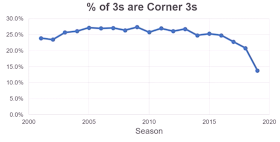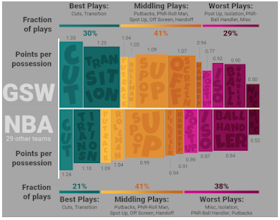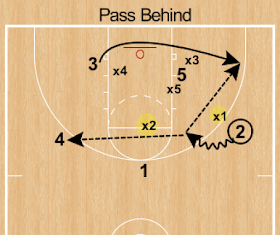I am grateful for their knowledge and willingness to share. Surely many other sites add value. The doctoring thing keeps me pretty busy.
This is a 'twofer' - Twitter feeds to bookmark and recent shares...some in-depth presentations to study (lots for me to learn).
Chris Oliver @BBallImmersion
This is more than a nerd-fest. It doesn't necessarily apply for youth ball with lower percentage shooting. Five topics:Had a blast presenting at the 2019 Final Four @NABC1927 Convention sharing 5 underutilized basketball strategies to increase win percentage.— Dribble Handoff (@dribblehandoff) May 30, 2019
Watch the full presentation here:https://t.co/5QxTH12hFT
1) Mid-range inefficiency (0.72 points/possession NCAA)
Bucks went from 11th to 29th in mid-range shots taken.
Fewest mid-range shots taken? Houston Rockets.
Each 5% absolute decline in mid-range equaled one win.
2) Corner 3. NBA corner 3 made at a 4% higher rate than 3s above the break. At NCAA level, 2.5% higher rate than other 3s although no break. More often less contested, more often catch-and-shoot shots. For every 3% more corner 3s taken vs allowed, another win.
NBA defenses are reducing corner 3s
3) Postups. Postups are declining but shots out of passes FROM the post are another 0.25 points/possession gain.
The "inside-outside" game works! Draymond, Horford, even Capella do this. But it also allows for "inverting" with passing guards in the post...Jalen Brunson who can pass or win at the rim.
4) Ball screen options. What works and what's done?
Take away what works and concede the lower percentage actions.
The NBA playoffs dramatically change the actions rendered.
5) Nonconference scheduling. Iron or cupcakes? Scheduling tougher nonconference opponents resulted in more conference wins. "Iron sharpens iron."
SeanBillermanHoops @HoopsSean
Coach Liam Flynn @CoachLiamFlynnGSW Ball Screen Concept - Shortening It pic.twitter.com/mgkk4D5IGo— SeanBillermanHoops (@HoopsSean) May 30, 2019
Radius Athletics @RadiusAthleticsI actually see this instinctive 'reverse pivot away' technique from bigs when they roll into traffic. Here's @utahjazz big @rudygobert27, short rolling into the pocket & using that technique to protect the ball (and not charging over D) before passing weak side to @spidadmitchell pic.twitter.com/XPf9QUbPpH— Coach Liam Flynn (@coachliamflynn) May 30, 2019
Gibson Pyper @HalfCourtHoopsNEW Video - #MotionOffenseTips - Steph Curry Down Screens 🔊 (ft. #CoachPaint by @CoachPaintCH) https://t.co/B7Uq61TVe1— Radius Athletics (@RadiusAthletics) May 30, 2019
Wes Kosel @HoopsChalkTalkSacramento Kings | Flip Angle Ballscreen Sethttps://t.co/udgB9pL1Oq— Half Court Hoops (@HalfCourtHoops) May 28, 2019
Coach Nick @BBallBreakdownPreparing Your Team for Late Game Situations https://t.co/DcOGA7Yt0O pic.twitter.com/cL2xV3OnDA— HoopsChalkTalk (@HoopsChalkTalk) October 23, 2017
Coach Daniel @IamCoachDanielThe Warriors have some secret sauce they use to win so many games. I identified what it is and how the Raptors may be able to stop it: https://t.co/IJxjUdMGwh— BBALLBREAKDOWN (@bballbreakdown) May 29, 2019
ZakBoisvert @ZakBoisvertNew video on some of the finer details about the Warriors offense and their screening. I breakdown how they attack top-lock, reversing the ball and more! https://t.co/XTMbxJpg9m— Coach Daniel (@IamCoachDaniel) May 20, 2019
This Punch action has become one of Kerr's favorite ATOs lately pic.twitter.com/gDk93zT8Mc— PickandPop (@PickAndPopNet) May 31, 2019
A previous omission, Coach Boisvert absolute belongs in any list of Twitter hoop video.
Lagniappe: I'm not a poker player, but the Phil Ivey MasterClass informs deeper thinking, bets, and reading opponents.






































